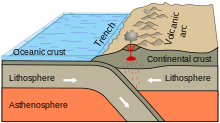Earth materials include minerals , rocks , soil and water . These are the naturally occurring materials found on Earth that constitute the raw materials upon which our global society exists. Earth materials are vital resources that provide the basic components for life, agriculture and industry .[1] [2] [3]
Oceanic-continental convergence resulting in subduction and volcanic arcs illustrates one effect of plate tectonics . Cross-cutting relations can be used to determine the relative ages of rock strata and other geological structures. Explanations: A – folded rock strata cut by a thrust fault ; B – large intrusion (cutting through A); C – erosional angular unconformity (cutting off A & B) on which rock strata were deposited; D – volcanic dyke (cutting through A, B & C); E – even younger rock strata (overlying C & D); F – normal fault (cutting through A, B, C & E).Alluvial gravels in Alaska A, B, and C represent the soil profile, a notation firstly coined by Vasily Dokuchaev , the father of pedology ; A is the topsoil ; B is a regolith ; C is a saprolite , a less-weathered regolith; the bottom-most layer represents the bedrock .
^ Study.com, Earth materials ^ Earth Materials: Introduction to Mineralogy and Petrology, by Cornelis Klein, Anthony R. Philpotts
^ Principles of Sedimentology and Stratigraphy, by Sam Boggs Jr.




